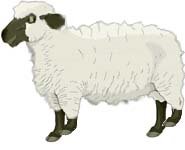What exactly is a Haggis?  So many people have asked me that I decided to blog the answer. So, we'll start off this month's posts with an explanation. I am sure that everybody is aware that the Haggis comes from Bonnie Scotland. Most people will also be aware that Scotland is a very hilly country. Britain's tallest peak "Ben Nevis" lies in the Scottish highlands. The highland hills can be very challenging - I know, I challenged them on a bicycle many years ago. The wildlife of the Highlands has adapted to the tough terrain in some very unique ways. One example of highland terrain adaptation is an animal that is found only in the Scottish Highlands. It is a member of the sheep family and is called the "Haggis".
So many people have asked me that I decided to blog the answer. So, we'll start off this month's posts with an explanation. I am sure that everybody is aware that the Haggis comes from Bonnie Scotland. Most people will also be aware that Scotland is a very hilly country. Britain's tallest peak "Ben Nevis" lies in the Scottish highlands. The highland hills can be very challenging - I know, I challenged them on a bicycle many years ago. The wildlife of the Highlands has adapted to the tough terrain in some very unique ways. One example of highland terrain adaptation is an animal that is found only in the Scottish Highlands. It is a member of the sheep family and is called the "Haggis".
 So many people have asked me that I decided to blog the answer. So, we'll start off this month's posts with an explanation. I am sure that everybody is aware that the Haggis comes from Bonnie Scotland. Most people will also be aware that Scotland is a very hilly country. Britain's tallest peak "Ben Nevis" lies in the Scottish highlands. The highland hills can be very challenging - I know, I challenged them on a bicycle many years ago. The wildlife of the Highlands has adapted to the tough terrain in some very unique ways. One example of highland terrain adaptation is an animal that is found only in the Scottish Highlands. It is a member of the sheep family and is called the "Haggis".
So many people have asked me that I decided to blog the answer. So, we'll start off this month's posts with an explanation. I am sure that everybody is aware that the Haggis comes from Bonnie Scotland. Most people will also be aware that Scotland is a very hilly country. Britain's tallest peak "Ben Nevis" lies in the Scottish highlands. The highland hills can be very challenging - I know, I challenged them on a bicycle many years ago. The wildlife of the Highlands has adapted to the tough terrain in some very unique ways. One example of highland terrain adaptation is an animal that is found only in the Scottish Highlands. It is a member of the sheep family and is called the "Haggis".The Haggis has one very unique and distinguishing characteristic. The legs on one side of the animal are markedly shorter than the legs on the other side (see the illustration). This evolutionary change enables the animal to remain upright while walking on steep Highland hillsides.
Haggis hunts are a popular spring activity in the highlands and are conducted in traditional highland attire accompanied by much pomp and ceremony. The sound of the pipes stirs the animal into a run. The haggis is very fast and quite ferocious when pursued but, of course, it can only run one way around the hills (it would topple and fall if it tried to run the other way). Haggis hunters catch the haggis by the simple expedient of running around the hill in the opposite direction to the animal.
When the Haggis is confronted by a hunter brandishing his claymore it freezes in fear (well wouldn't we all freeze in fear if confronted by a belligerent, kilted highlander with a claymore?) and succumbs to its fate.
Haggis meat gets its unique flavour from the animal's diet. The haggis subsists on wild onions and oats so you will often find these items listed in the ingredients on the meat packaging.
So now you have the definitive answer to the question of "what is a haggis?". This explanation makes a great conversation topic at parties, bars and social events. Spread the word.
